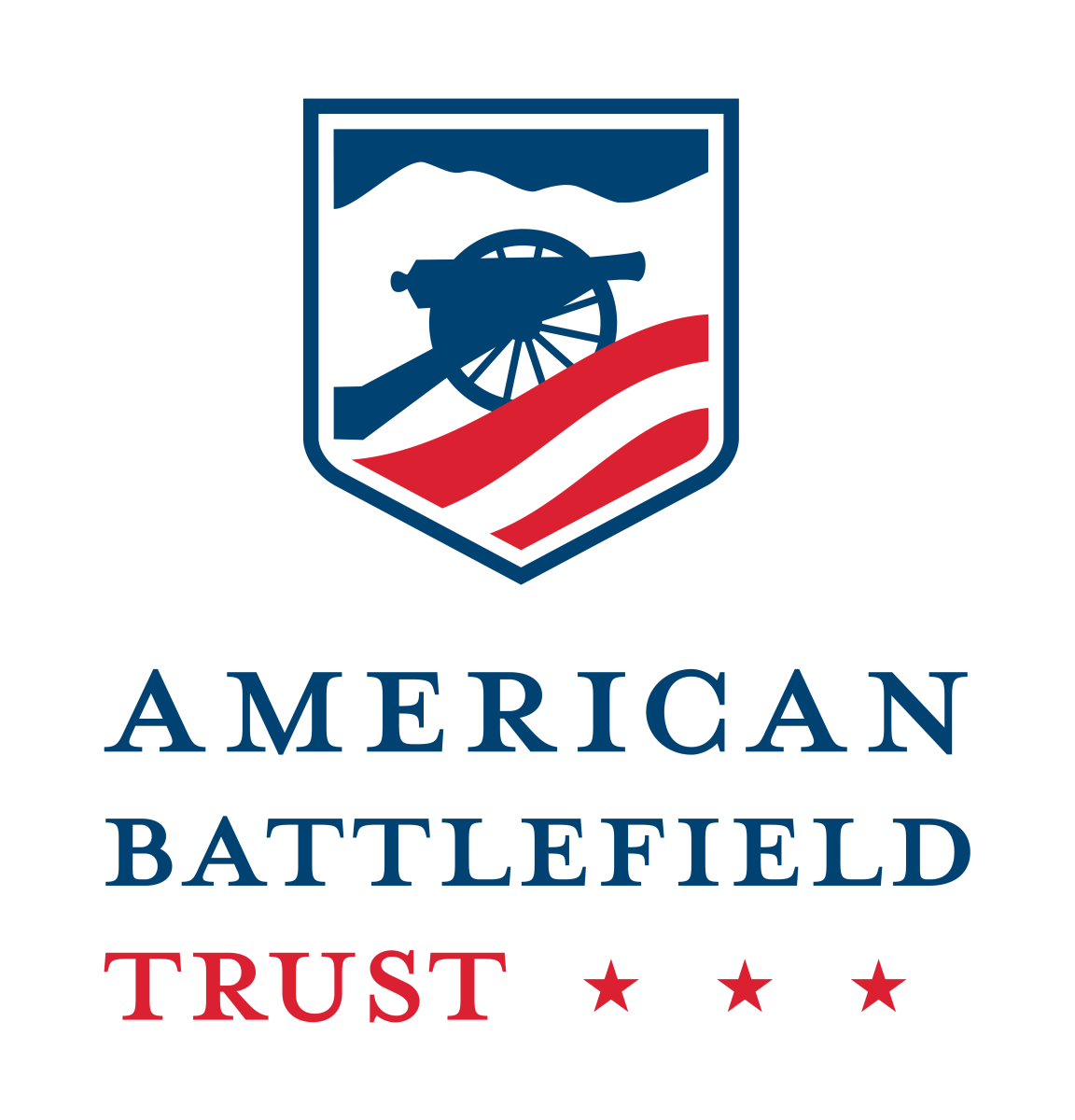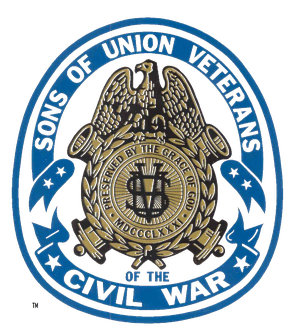Historian D. Scott Hartwig weighs in on whether George McClellan acted swiftly enough after receiving a copy of Robert E. Lee’s operational orders for the 1862 Maryland Campaign.
Transcript
Terry Johnston: Scott, thanks very much for joining us. Our first question for you is from Paul in Alabama, who asks, “Why did Army of the Potomac commander George McClellan wait so long to do anything after Union forces found a copy of Robert E. Lee’s Special Orders 191 during the Maryland Campaign?” Now, before we get your answer to that, perhaps you might first provide some context for listeners not overly familiar with the 1862 Maryland Campaign in general or Special Orders 191 in particular. So, set the scene for us. What was S.O. 191? What was happening at the time Lee issued it? And how did a copy end up in George McClellan’s hands?
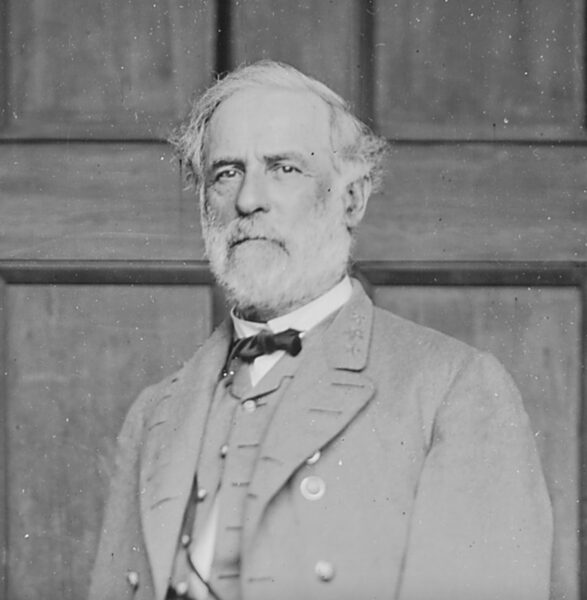 National Archives
National ArchivesRobert E. Lee
Scott Hartwig: Special orders were orders that were meant for the entire army. It was generally something that was distributed to commanders who were going to be commanding different units in an operation. And the reason that Lee is issuing Special Orders No. 191 is because he has invaded Maryland. He won a big victory in the Battle of Second Manassas at the end of August, and he decided the best way to capitalize on that victory was to take his army across the Potomac River into Maryland. He saw enormous political advantages in this because this is obviously a political war and he is seeking to gain an advantage in gaining southern independence by influencing the politics in the North.
So he carries his army into Maryland. He marched his army to Frederick, Maryland, which is centrally located. It was a deliberate choice by Lee. His troops needed a chance to rest, so he spent three days in the Frederick area. What he was really doing there besides resting his troops and also foraging for supplies was assessing the Union reaction. Because when he was in Frederick, he posed a threat to Pennsylvania to the north, he posed the threat to Baltimore to the east, and he posed a threat to Washington, D.C., to the southeast. The reason he’s in Frederick is he is hoping that position will draw the Union army out of its fortifications around Washington—out into what the army in that period called “out into the open,” where Lee can then move west of Frederick, over the Catoctin Mountains and the Blue Ridge called South Mountain in Maryland, and on up into Pennsylvania, drawing the Union army far away from its base of supply and its fortifications. And then he’s confident that he can fight and beat that army out in the open, maybe in Pennsylvania, maybe in Maryland. He doesn’t know where it’s going to be.
Anyway, he learns by the 9th of September that the Army of the Potomac has sortied forth out of Washington, D.C. So that’s what he wants. But the other thing he learns before the 9th, he learns that there were two Union garrisons in the lower end of the Shenandoah Valley. And when we say lower end of the Shenandoah Valley, we mean the northern end of the Shenandoah Valley. That’s the lower end. That’s what they referred to as the lower end. And that is a garrison at Harpers Ferry and a smaller garrison at Martinsburg, Virginia—they’re not West Virginia yet, still Virginia. Those two garrisons number about 13,000 men, and they are squarely on the line of communications and supply that Lee will use when he moves into western Maryland and on into Pennsylvania. So he can’t let those garrisons remain there. He thought the Union high command would withdraw them, but they didn’t do that. So he decided he saw an opportunity here that he could capture those garrisons before the Union Army of the Potomac came up with him. So he thought he could execute this movement, capture those garrisons, reunite his army to face the Army of the Potomac when it gets into western Maryland or up into Pennsylvania, depending on where Lee can get.
So he draws up the plan. And the plan is Special Orders No. 191. And on September 9 it is issued to all subordinate commanders who are named in the order. All of them are going to get a copy of the order. It’s drawn up at Lee’s headquarters. And the orders are written by Robert Chilton, who is essentially Lee’s chief of staff at headquarters. So, Chilton writes the orders up. The orders are carried out to Stonewall Jackson, James Longstreet, Lafayette McLaws, etc. All the different commanders.
The way this typically works in a Civil War army is when an order is taken out and it is delivered to a commander, that commander signs a receipt, which he gives to the courier. The courier returns to headquarters, gives the receipt to the headquarters staff. They enter into the books there at headquarters that the order has been received. That way you know that the order wasn’t mislaid or wasn’t delivered, or something like that. You know that the commander has received the order. And you may not know what time he received it, but you know that he’s received it.
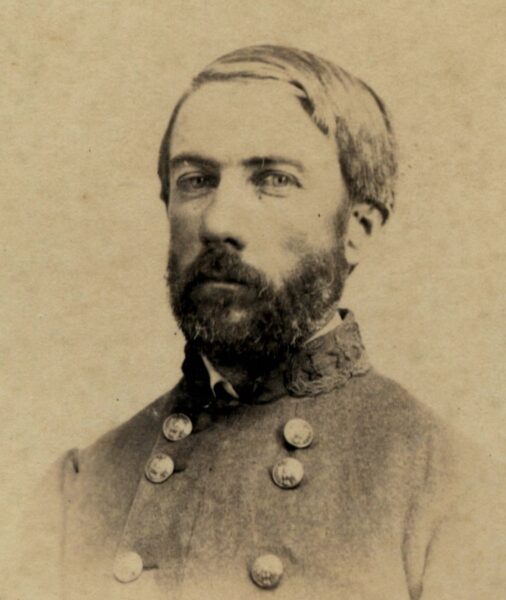 University of South Carolina Libraries
University of South Carolina LibrariesD.H. Hill
So that’s the way it’s supposed to work. So, the orders go out. And when Stonewall Jackson received his copy of Special Orders 191, he noticed on there that D.H. Hill’s division was going to operate independently. So during the Maryland Campaign—this is important—D.H. Hill had been attached to Stonewall Jackson’s command. And the Confederates had a very fluid command structure. It was one of their problems in Maryland. So Jackson sees that D.H. Hill will be detached. So Jackson decides, well, Hill should know what these orders are. He doesn’t know Hill is getting the copy of the orders. So, Jackson writes out in his own hand the pertinent sections of the orders that D.H. Hill needs to know, gives them to a courier, courier departs, delivers the orders to D.H. Hill, and comes back to Stonewall Jackson.
The courier from army headquarters carrying the orders to D.H. Hill—and this is where it gets really strange and weird—the orders are in an envelope, a manila envelope, and they are wrapped around three cigars. And that courier, or it’s possible it was somebody at D.H. Hill’s headquarters—I don’t think we will ever know—somebody drops that package in the camps of D.H. Hill’s division. Now D.H. Hill claims he never received the orders. Now he’s got a pretty good argument that he makes, because there is no evidence that we’re aware of that headquarters ever got a receipt back or any sort of indication that D.H. Hill had received these orders. So for some reason the orders are dropped in a field where D.H. Hill’s division—and we’re talking about a big unit here. Hill’s division is over 5,000 men. It’s five brigades of infantry. So, we don’t know exactly the precise point where the orders are dropped. It’s just dropped in a grassy field. And D.H. Hill never gets the orders. And army headquarters never takes note of this. This is also really significant.
Terry Johnston: Yeah.
Scott Hartwig: They’re packing up. Army headquarters is packing up because the army’s going to make this move on September 10. And it’s possible in the hullabaloo that this just slipped through the cracks. But the whole thing is rather weird. So the orders are dropped. The next day, September 10, the Army of Northern Virginia marches out of Frederick and begins to execute the Harpers Ferry operation.
Meanwhile the Army of the Potomac is advancing up towards Frederick, Maryland. On September 13, the Union XII Army Corps crosses the Monocacy River. And the leading unit was the 27th Indiana Infantry. They were part of General George Gordon’s brigade of infantry. And the 27th led the brigade in crossing the Monocacy River, a little bit southeast of the city of Frederick. It crossed over the river. There were warnings to Gordon that he should expect to face opposition. There were still believed to be Confederate forces around Frederick. They deployed the 27th Indiana in a skirmish line, and they advanced into this big meadow—which had been part of the camps of D.H. Hill’s division—with the rest of the division crossing over behind them and forming a line of battle.
As they’re moving across this meadow, somebody comes up and informs the 27th and informs General Gordon, Hey, the IX Corps is already in Frederick and there’s no Confederates here. They’re gone. So, good deal, right? So they order the regiment to fall in from the skirmish order and stack rifles. So everybody’s going to take a break. And they’re beginning to assemble as a regiment and getting ready to stack their rifles when Corporal Barton Mitchell in the 27th Indiana looks down into the grass and he sees this envelope laying there. He picks it up, he opens it up, and he saw a piece of paper wrapped around three cigars. A piece of paper doesn’t mean anything to Corporal Mitchell. He can’t read. So, it doesn’t mean anything to him. The cigars, too, he is like, this is great. So he starts handing out the cigars and he shows the piece of paper to his sergeant, John Bloss. And John Bloss is well educated. And John Bloss actually starts reading the document out loud. And as he gets just through the very heading of it, he realizes this is a very important document. This is some sort of a special order from the Rebel army.
So he takes the cigars back from Mitchell and this other private named Vance. He wraps the order back around it. He goes over to his company commander and he shows him the order. The company commander says, wow, this looks really important. They go to the commander, Colonel Silas Cosgrove, and he hasn’t even gotten off his horse yet. And they show him the order. He reads the order and he is like, wow, this is really important. And he gallops off to find corps headquarters. When he gets to corps headquarters, he delivers this message and the corps commander, his name is Alphaeus Williams, is not there at that moment. The only people who are there are Samuel Pittman, who is the assistant adjutant general (that’s the staff officer at corps headquarters), the chief of artillery, and I think the provost marshal of the corps was there.
So there’s just a few staff officers at the headquarters. They’ve just arrived. They’ve just gotten across the Monocacy River and they start looking at this order and there’s a debate that ensues. The other two staff officers besides Pittman look at it and they go, You know what? This is just a trick. This is a ruse by the Rebels. They just planted this here. But Pittman, in just an unbelievable twist, had been a teller at a bank in Detroit, Michigan, before the war. And the U.S. Army paymaster at the army post in Detroit, Michigan, his name was Robert Chilton. And Robert Chilton did his banking at the bank that Pittman worked at. And Pittman looks at the signature and he goes, that is Chilton’s signature. I think this order is actually genuine.
Terry Johnston: Wow.
Scott Hartwig: So Alpheus Williams shows up and then Williams takes the order, writes a cover note for it, saying this order was discovered by a corporal—I thought it was really cool that Williams acknowledged that a lowly corporal is the guy who found this—and the order is believed to be genuine. And he tells a trusted courier to find army headquarters and deliver this to General McClellan. So that’s what leads up to the orders making their way to George McClellan.
Terry Johnston: Do we know exactly when McClellan would’ve received them? Do we have an idea of that at all? Was it pretty quickly after it was determined to be legitimate?
Scott Hartwig: Yeah. We don’t know the exact time that McClellan received the orders. So the 27th Indiana crossed the Monocacy River about 9 a.m. in the morning. So certainly before 10 a.m. in the morning, Because all of these things that I just described happened really pretty quickly.
Terry Johnston: Okay.
Scott Hartwig: So the order probably went out and I wouldn’t imagine it would’ve taken more than about an hour to find army headquarters. Now, what we know about McClellan’s actions that day is when he and his headquarters rode into—now, again, when we talk about headquarters, don’t imagine that this is some elaborate structure in a building and there’s everybody around. The headquarters are moving on September 13. They’re not established on the morning of the 13th, they’re moving into Frederick. And McClellan arrives with his staff into Frederick and the first thing that he does is he meets with Ambrose Burnside, who’s commanding the right wing of the army, the I Corps and the IX Corps. And the IX Corps led the movement into Frederick. So we know he meets with Burnside at about noon. How long that meeting was, we don’t know. Now it had been accepted, I think, by some historians that it’s probably when McClellan was meeting with Burnside that he received Special Orders No. 191. I don’t think that’s the case. I don’t think he received them there. Because I think that whoever the courier was from XII Corps headquarters actually delivered them to army headquarters. And McClellan wasn’t where they were establishing the headquarters. The headquarters were being established at a point just north of the city of Frederick.
So that would be his chief of staff, Randolph Marcy, all these other staff officers. I mean, that’s kind of the administrative heart of the Army of the Potomac. McClellan, after he meets with Burnside, rides through the east side of Frederick because the II Army Corps is arriving in Frederick. And the people in Frederick are flocking into the streets. Hundreds, thousands of people coming out into the streets. They’re so excited because this is a very Union town. They were frightened out of their wits by the Confederates being there for three days. They’re overjoyed to see the Army of the Potomac. They’re overjoyed to see McClellan. The women are throwing flowers at him. It’s just overwhelming. He’s having a great time. He’s watching the II Corps come in. These are his Peninsula veterans. He loves the II Corps. And he kind of revels in the moment up until probably around 1:30 in the afternoon, when we know he stops briefly to talk to Jacob Cox, a division commander in the IX Army Corps who had served with McClellan in western Virginia in 1861. They knew each other. And Cox’s division has been ordered to march out the National Road. It runs west from Frederick over Catoctin Mountain, over South Mountain. And Cox’s job is to go out and support the cavalry under Alfred Pleasanton, which is skirmishing with Jeb Stuart’s cavalry in the pass through the Catoctin Mountains. And Pleasanton is having a hard time getting through there. He needs infantry and McClellan had approved sending Cox’s division to reinforce Pleasanton.
 Frank Leslie's Illustrated History of the Civil War
Frank Leslie's Illustrated History of the Civil WarGeorge McClellan is depicted entering Frederick, Maryland, to the cheers of the town’s unionist population.
So McClellan pauses at about 1:30 to speak the Cox, to tell him what the situation is or what to expect and how to help Pleasanton. Then McClellan makes his way to his headquarters. So this is probably sometime after 1:30, maybe two o’clock, when he’s first going to see Special Orders No. 191.
Terry Johnston: Well, that gets us to Paul’s question. So he gets it around that time and, as Paul asks, why did McClellan “wait so long” to do anything with it after receiving it? Did he wait so long in your estimation? Or did he act rather decisively? I know there’s debate among historians today about how to characterize McClellan’s actions after getting S.O. 191.
Scott Hartwig: Yeah. Well, there’s always going to be debate about this because people have strong opinions about McClellan. But in this particular instance, I think McClellan acted appropriately. One of the things that makes people think that McClellan didn’t do anything for a long time is the belief for many, many years that McClellan sent a message to Abraham Lincoln, President Lincoln, at noon. Because the message that is in the Official Records from McClellan to Lincoln, its time signature is “12 M.” And at McClellan’s headquarters, typically “M” was “Meridian”: 12 noon. If it was at 12 noon, that’s how they time signatured the thing.
However, in this case, the message that McClellan sent to Lincoln was actually carried down to a telegraph station, and from there it was transmitted back to the White House. And they didn’t actually receive the message until midnight. Now, a researcher named Tim Reese was doing some research some years back in the Library of Congress, looking through Lincoln’s papers, and he found this message, the “12 M” message. And somebody back then had written on the message “midnight” after the “M,” so 12 midnight. Now that for some people might not be conclusive. However, when you look at all the sequence of events and the fact that this had to travel a little bit to get to the telegraph station, then be transmitted by telegraph, and you look at the timing of the correspondence that McClellan carries out throughout September 13, it makes perfect sense. It is absolutely logical that he does not write to Lincoln until 12 midnight.
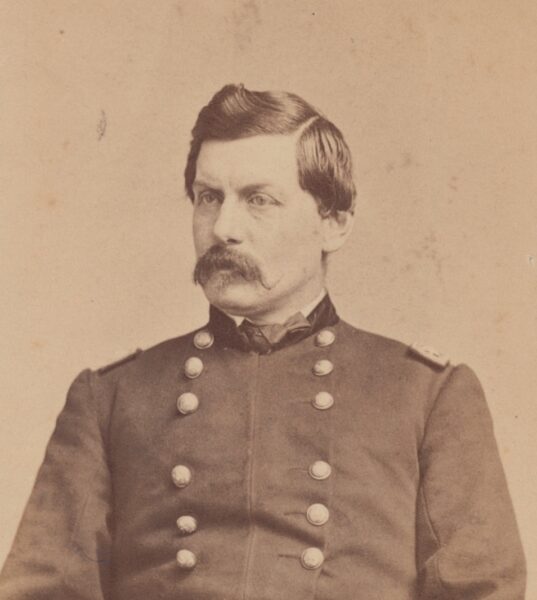 Library of Congress
Library of CongressGeorge B. McClellan
Here’s what I think happened. McClellan receives the order, and when he gets the order, there were people who had gathered at the headquarters, local people. Because everybody wants to tell the guys in uniform what they saw when the Rebels were in town. And also, when you’re in a town like Frederick, there are some people who are friendly to the Confederates and they might want to see what’s going on at headquarters, right? And there was an individual who was present—allegedly—when the order was brought to McClellan, he was not in his tent. He was standing out in the open. He read the order and allegedly what he said was, “Now I know what to do.”
This individual—we don’t know who this person was, but we know that they existed—may have also seen Jacob Cox’s division departing Frederick at 1:30 and concluded from what he observes and maybe even what he heard that a major offensive is in the offing by the Army of the Potomac and the Confederates need to know about it. And he leaves. And on the night of September 13 on Turner’s Gap at South Mountain, he is going to share this information with Jeb Stuart, the Confederate cavalry commander.
He doesn’t share with him, “oh, they got special orders number 1 91.” You’ll hear that story sometimes That’s not true. This guy didn’t know that that order had been captured. The confederates didn’t know that. All he knew is that they got some sort of intelligence that they’re confident and it looks like a major movement is underway. There was, however, a leak from headquarters. Because the next day in a [00:18:00] Baltimore newspaper, there was an article that said, “Confederate Special Order No. 119 discovered in Frederick.” So somebody leaked it, but they got the numbers wrong.
Anyway, so McClellan has received the orders. He says, “Now I know what to do.” And then, everybody heaps criticism on him because they’re like, oh my God, why didn’t he just start get everybody moving? Go take on the Confederates. And what I usually ask people when we talk about this, I’m like, okay, put yourself in McClellan’s shoes. You just received this order, and a note is on it from Alpheus Williams. They believe the order to be genuine. Is it? A hundred percent certain? Because you’re going to send 80,000 men in motion. You are going to commit your army to this movement. And once you commit your army to this movement, you don’t just change it. That’s a huge deal in a 19th century army. It’s a huge deal in a 21st century army. So, you better be certain that this is correct because there’s nothing in this order that says any Confederates are supposed to go to Hagerstown. Yet McClellan has a great deal of intelligence that there are Confederates in Hagerstown. Nothing in this order says Confederate troops are supposed to cross the Potomac River near Williamsport. Yet, Confederates were reported crossing large forces, crossing the Potomac River at Williamsport. So, did they follow this order?
So the very first thing you’re going to do if you’re George McClellan is you want to make sure that this is genuine and that they followed the order. So at 3 p.m. the pertinent sections of the order are written out by a member of McClean’s staff and sent to Alfred Pleasanton who’s out west of Frederick skirmishing with Jeb Stuart’s cavalry. And they ask Pleasanton to determine, if he can, if the Confederates followed this order of march.
Now we have to also presume because McClellan did have somewhat of an intelligence service. He had Alan Pinkerton, who had formed the Pinkerton [Agency when McClellan had been in the railroad industry before the war. And Pinkerton was present with the army and he may have been questioning civilians in town. I mean, there were also some military people who were in town who weren’t taken prisoner by the Confederates because they were medical personnel. All of these people could potentially provide information about what they observed on September 10.
So what we know is, by 6:20 p.m., George McClellan was convinced that this order was genuine. And it’s at that time period he writes his first orders. And those first orders, which are very detailed and very long, are sent to William B. Franklin, who commands the VI Army Corps. Because Franklin is going to operate independent in this operation. So that’s the reason Franklin gets these very, very detailed orders.
And then as the evening progresses, all the other important commanders are going to get their orders. Also, McClellan gets criticized, like, he didn’t move anybody. He should have moved soldiers into the Middletown Valley over the Catoctin Mountain range. He didn’t do that. Well, yes, he did. So Jacob Cox’s division helps Pleasanton’s men clear the way over Catoctin Mountain. They descend in the Middletown Valley. It’s this big beautiful valley that extends towards South Mountain. And South Mountain, if you’ve never been there before, rises in this area to over 2,000 feet. It’s a very formidable obstacle. It’s crossed by the National Road. So it is a very important geographic point because what McClellan knows is that a large Confederate force, including Robert E. Lee, James Longstreet, and D.H. Hill, are supposedly located in Boonsboro. Boonsboro is on the immediate west side of South Mountain. And he knows that capturing Maryland Heights that dominates Harpers Ferry, that is held by two Confederate divisions, Lafayette McLaws’ division and Richard Anderson’s division. Both of them are under McLaws’ command.
So they have besieged Harpers Ferry. McClellan can even hear the guns in Harpers Ferry, the artillery firing down there. And he knows that Harpers Ferry has Jackson’s command. And what is a command? You have no idea. McClellan has zero idea about the order of battle of the Confederate army. A command is probably, you would think, an army corps, but it could be bigger, you don’t know. And another independent division, General John G. Walker’s division. So there’s a very substantial Confederate force at Harpers Ferry, but this is where the Confederates are supposed to be. But again, remember, McClellan also has reports of Confederates being in Hagerstown. He doesn’t who those might be.
So he develops a plan of attack, and the plan of attack is he will send the VI Army Corps, reinforced by Darius Couch’s division from the IV Corps, a force of about 19,000 men. They are going to be the southern prong of an offensive, and their job is going to be to breakthrough at Crampton’s Gap, which is just a few miles away from Harpers Ferry, get into McLaws’ rear, destroy McLaws and Anderson, liberate the boys at Harpers Ferry, and then they’re supposed to march north and assist McClellan in what’s going to be the big battle against the Confederate force in Boonsboro.
McClellan does not make any provision for a battle at South Mountain. He orders all the rest of his army, which is about 65,000 troops, to march on the National Road. So you’re putting all these troops on one road. Really good road. But to put this in perspective, when the head of the column reached the summit of South Mountain 14 miles away, the tail of the column would still be in camp in Frederick.
Terry Johnston: Wow.
Scott Hartwig: So we’re talking about a column, if you’ve got 65,000 men, that’s going to extend over 20 miles. What it means is it’s going to take McClellan all day, literally, to get his army up if the Confederates resist at South Mountain, to really deploy the army for any sort of offensive action.
So, to get back to the question here, I think McClellan acts appropriately in this situation. He develops a plan. There are some criticisms I have of his plan. But in general, the plan is a pretty good plan. He’s taking action. He’s moving forces. Everybody knows what they’re supposed to be doing. He’s not sitting around twiddling his thumbs, not doing anything. And It’s not until 11 p.m. that he writes Henry Halleck, the general-in-chief or like the chief of staff of the army. He writes him about the fact that he says they found some of the plans of the Rebels. Now, an hour later when he writes the president at midnight, he says we’ve got all the plans of the Rebels. Anyway, that just might be, you know, who knows why they use those words.
So I think he acted appropriately. I don’t think he acted slowly. I don’t think he was too cautious. I think he was taking aggressive action, which for McClellan, when you think about his performance in the Peninsula, this was a really positive step. So, I don’t see him dragging his feet here.
About the Guest
 D. Scott Hartwig, former supervisory park historian at Gettysburg National Military Park, retired in 2014 after a 34-year career at the National Park Service. He is the author of To Antietam Creek: The Maryland Campaign From September 3 to September 16 (Johns Hopkins University Press, 2012) and I Dread the Thought of the Place: The Battle of Antietam and the End of the Maryland Campaign (Johns Hopkins University Press, 2023).
D. Scott Hartwig, former supervisory park historian at Gettysburg National Military Park, retired in 2014 after a 34-year career at the National Park Service. He is the author of To Antietam Creek: The Maryland Campaign From September 3 to September 16 (Johns Hopkins University Press, 2012) and I Dread the Thought of the Place: The Battle of Antietam and the End of the Maryland Campaign (Johns Hopkins University Press, 2023).
